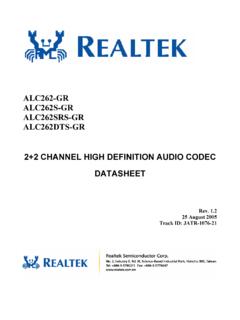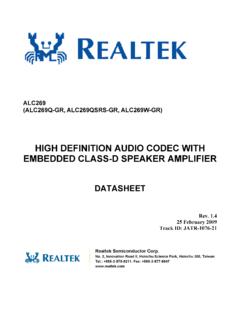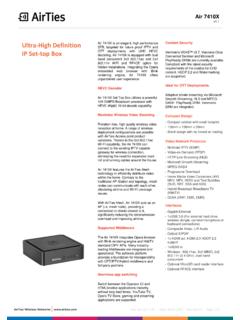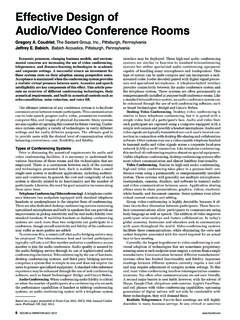Transcription of Definition of Assistive Technology Devices and …
1 Georgia Project for Assistive Technology Division for Special Education Services and Supports 1870 Twin Towers East Atlanta, GA 30334 Phone: 404-463-5288 FAX: 404-651-6457 Website: 1 Developed by the Georgia Project for Assistive Technology (September 2004). Permission to copy for non-commercial purposes is granted if this credit is retained. For additional information, contact GPAT by email at Definition of Assistive Technology Devices and Services Assistive Technology Devices and services were first defined in federal law in the Individuals with Disabilities Education Act of 1990 (Public Law 101-476). These definitions remained unchanged until 2004 with the passage of the Individuals with Disabilities Education Improvement Act (Public Law 108-446) when an exemption to the Definition of an Assistive Technology device was added to clarify a school system s responsibility to provide surgically implanted Technology such as cochlear implants.
2 Assistive Technology Device: Assistive Technology Devices are identified in the IDEA 2004 as: Any item, piece of equipment or product system, whether acquired commercially off the shelf, modified, or customized, that is used to increase, maintain, or improve the functional capabilities of children with disabilities. The term does not include a medical device that is surgically implanted, or the replacement of such device. (Authority 20 1401(1)) Although the IDEA uses the term device , it is important to recognize that Assistive Technology Devices required by students with disabilities include hardware and software as well as stand-alone Devices . Almost any tool can be considered to be an Assistive Technology device except for those Assistive Technology Devices that are surgically implanted and have been excluded from the Definition of an Assistive Technology device as defined in IDEA.
3 The Definition of an Assistive Technology device is very broad and gives IEP teams the flexibility that they need to make decisions about appropriate Assistive Technology Devices for individual students. Assistive Technology includes Technology solutions that are generally considered instructional Technology tools, if they have been identified as educationally necessary and documented in the student s IEP. For example, a classroom computer with a word processing program can be considered Assistive Technology for a student who demonstrates difficulty in writing and spelling if the IEP team has determined that it is educationally necessary. Assistive Technology Devices can be purchased from a local store or a vendor that specializes in the production and sale of Assistive Technology Devices .
4 These Devices often need to be modified or customized to meet the individual needs of a student with a disability. For example, a computer keyboard may need to be adapted through the addition of tactile locator dots for a student with a visual impairment. When determining Assistive Technology needs, IEP teams should consider commercially available solutions that may be used as is or ones that can be modified to meet the student s unique needs. In some situations, it may be necessary to construct a device to meet the student s unique needs. A range of Assistive Technology Devices are available. Some are relatively low Technology and inexpensive. For example, a pencil grip is an Assistive Technology device that may be used by a student with a physical disability to improve handwritten communication through increasing the student s grasp of and control over his or her pencil.
5 An adapted cup with enlarged handles may be used by a student who has difficulty holding a standard cup. Other Devices are more high Technology tools and are often more expensive. An example of a high Technology tool is an augmentative communication device in which a student types in messages on a communication display and they are spoken aloud. Assistive Technology Devices are available in a variety of categories to address functional capabilities of students with disabilities. These categories include but are not limited to: Developed by the Georgia Project for Assistive Technology (September 2004). Permission to copy for non-commercial purposes is granted if this credit is retained. For additional information, contact GPAT by email at 2 Academic and Learning Aids: Electronic and non-electronic aids such as calculators, spell checkers, portable word processors, and computer/tablet-based software solutions and apps that are used by students who has difficulty achieving in the educational curriculum Aids for Daily Living: Self-help aids for use in activities such as eating, bathing, cooking, dressing, toileting, and home maintenance Assistive Listening Devices and Environmental Aids.
6 Electronic and non-electronic aids such as amplification Devices , closed captioning systems, and environmental alert systems that assist students who are hard of hearing or deaf with accessing information that is typically presented through an auditory modality Augmentative Communication: Electronic and non-electronic Devices and software solutions that provide a means for expressive and receptive communication for students with limited speech and language Computer Access and Instruction: Input and output Devices , alternative access aids, modified or alternative keyboards, switches, special software, and other Devices and apps or software solutions and that enable students with disabilities to use the classroom computer/tablet Environmental Control: Electronic and non-electronic aids such as switches, environmental control units, and adapted appliances that are used by students with physical disabilities to increase their independence across all areas of the curriculum Mobility Aids: Electronic and non-electronic aids such as wheelchairs (manual and electronic), walkers, scooters that are used to increase personal mobility Pre-vocational and Vocational Aids: Electronic and non-electronic aids such as picture-based task analysis sheets, adapted knobs, and adapted timers and watches that are used to assist students in completing pre-vocational and vocational tasks Recreation and Leisure Aids.
7 Electronic and non-electronic aids such as adapted books, switch adapted toys, and leisure computer-based software applications that are used by students with disabilities to increase participation and independence in recreation and leisure activities Seating and Positioning: Adaptive seating systems and positioning Devices that provide students with optimal positioning to enhance participation and access to the curriculum Visual Aids: Electronic and non-electronic aids such as magnifiers, talking calculators, Braille writers, adapted tape players, screen reading software applications for the computer, and Braille note-taking Devices that assist students with visual impairments or blindness in accessing and producing information that is typically present in a visual (print) modality.
8 (Adapted from the Assistive Technology Guidelines for Kentucky Schools, Kentucky Department of Education) A particular student with a disability may require Assistive Technology solutions from one or more of the above categories. For example, a student with a severe intellectual disability may use an augmentative communication device to supplement his or her communication skills, adaptive switch toys to participate in leisure activities, and an adapted keyboard for accessing the software applications on the classroom computer. The above listed categories of Assistive Technology Devices are not disability specific. For example, a student with a learning disability who has difficulty focusing on the teacher s lecture in class due to processing difficulties may require an Assistive listening device to amplify the teacher s voice in a classroom.
9 Students with various types of disabilities use adapted tape recorders originally developed for visually impaired and blind children to access audio-taped reading materials. The need for Assistive Technology Devices is determined by the student s IEP committee. Typically, Assistive Technology solutions are identified through consideration of Assistive Technology or through an Assistive Developed by the Georgia Project for Assistive Technology (September 2004). Permission to copy for non-commercial purposes is granted if this credit is retained. For additional information, contact GPAT by email at 3 Technology assessment. Once an Assistive Technology device has been determined educationally necessary, the student s IEP team should document the required device(s) in the IEP.
10 Information on considering and assessing the need for Assistive Technology Devices and documenting Assistive Technology Devices is included in subsequent sections of this manual. Assistive Technology Service: As defined in IDEA, an Assistive Technology service is Any service that directly assists a child with a disability in the selection, acquisition, and use of an Assistive Technology device. The term includes - a. The evaluation of the needs of a child with a disability, including a functional evaluation of the child in the child s customary environment; b. Purchasing, leasing, or otherwise providing for the acquisition of Assistive Technology Devices by children with disabilities; c. Selecting, designing, fitting, customizing, adapting, applying, retaining, repairing, or replacing Assistive Technology Devices ; d.







